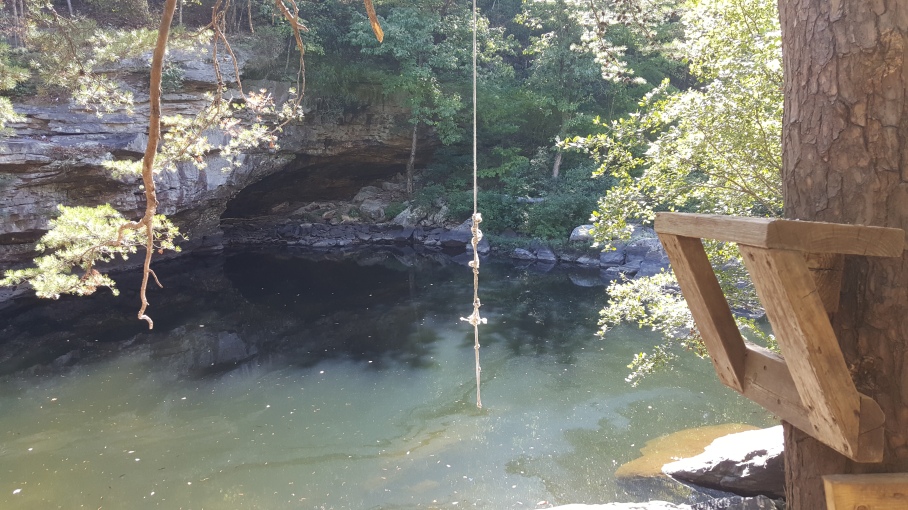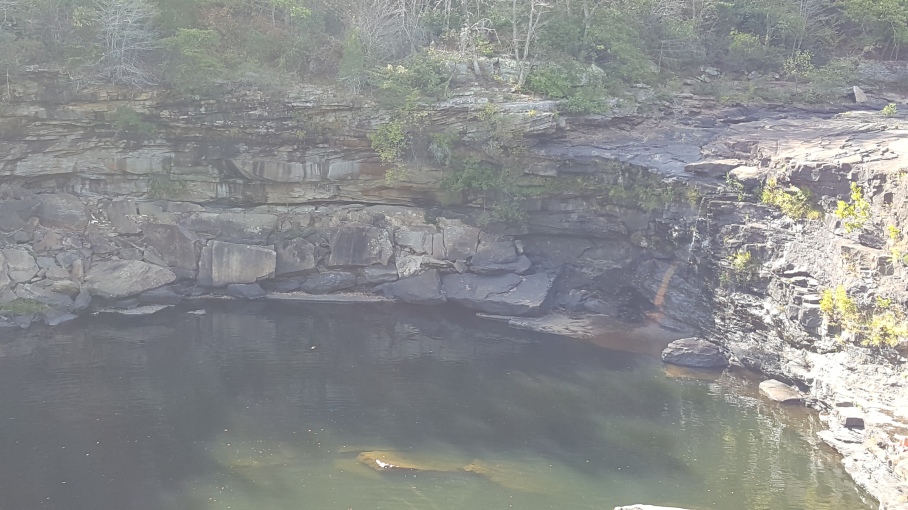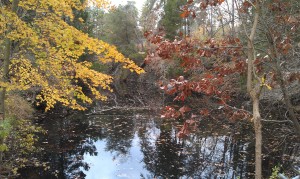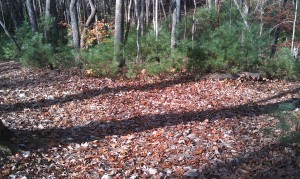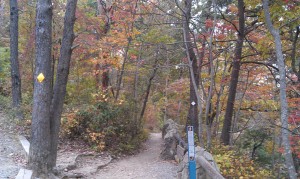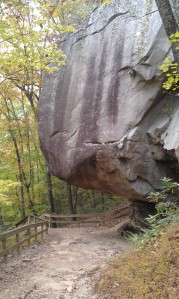It seems that I’ll be spending some time down south during the beginning of fall, so for my first autumn hike, I decided to visit a humble spot within the North Georgia Mountains: James H. Sloppy Floyd State Park. Situated at the base of Taylor Ridge, Floyd Park is a unique spot that truly offers something for everyone. The park was named in honor of a state politician that served just over two decades.
After driving into the park’s boundaries via a road of the same name, James H. Sloppy Floyd State Park immediately offers excellent lakeside views, complete with lush vegetation and camping spots. The mountain peaks of Taylor Ridge rise just above, creating a unique picturesque setting. Fishing is available to license holders in a variety of locations, including a walking bridge that stretches across one of the lakes. Kayak and pedal boat rentals are also available, though they appeared to be out of season.

Of course, I came here to enjoy an autumn hike, so the park’s trails are my destination. It features four in all: two easy trails circling around the lakes, a moderate trail that takes visitors past the marble mine and up to the summit of Taylor Ridge, and a rigorous trail that also scales the nearby mountain. Each of the more challenging trails also connect with the Pinhoti National Recreation Trail. After reviewing the map, I noticed that the upper lake trail crosses over the north lake before connecting with the Marble trail, so I decided to set this as my course. Despite visiting in mid-October, it still felt more like a summer hike that autumn. Green, luscious trees and foliage surrounded me, and the local high reached into the lower 80s. Still, the air was relatively dry (given Georgia’s infamously high levels of humidity), and patches of autumn colors could be seen breaking through the landscape.

I began my hike by setting out on a walking bridge that crossed the upper lake. A few parents were teaching their children how to fish, and the available catches seemed plentiful for the catch After crossing over the Upper Lake, the trailed passed by a scenic picnic area before shifting into the woods. Shortly after entering the forest, I noticed a side trail cutting to the left. Since the map had identified this as the connector to the marble mine trail, I decided to take it. Not long after, I came across an intersection with another trail. I didn’t remember seeing this on the map, so I reached to pull it out and confirm my route- only to realize that I had left it in my car. Not the most ideal of circumstances, but I was feeling adventurous, and didn’t really feel like going back to my car anyway. So, I pressed on.

Marble Mine Trail is classified as moderate, and it’s easy to see why. The path is anything but flat, and can become somewhat rugged at times. Still, I found that by stepping carefully and looking to the trail ahead, I could easily avoid the most strenuous terrain by sticking to the side. The surrounding woods still seemed like more of a summer than autumn hike (minus the humidity), but the change was becoming evident. I actually found more fall colors scattered across the ground than I did in the trees and brush.
One aspect of hiking I have learned is that distance seems much more varied within a thick forest landscape than walking in the city or even a flat, paved path (especially when you forget to bring the map). I was eager to see the geological wonder that is the marble mine’s reflecting pool (only .7 miles according to the last sign), but my trek seemed to be taking much longer than that. I began to consider searching for an online map with my Android phone despite limited, slow service, when a rather creepy looking dark area suddenly appeared on the path ahead. The sun’s sun’s light was illuminating my surroundings quite well despite the thick branches above, yet this particular area appeared dark as night.

I inched closer until I heard the sound of falling water. I picked up the pace a little faster and discovered that my autumn hike had finally led me to the very geological structure that made this park famous: the Marble Mine Reflecting Pool. I found it a rather unique site for the trail I had traversed so far. A thin waterfall cascades over the top of the cave and lands gently into the small pool of water below. Behind that, a wooden walkway leads deeper inside. I tried snapping a few photos of the cave, but the sun just happened to be in the perfect spot to ruin my chance. You can see the result below.

Once inside, I found some interesting geological formations reminiscent of a beginner rock climber’s dreams come true. The rocky walls were rather jagged, leading up to a surprisingly smooth ceiling. Small streams of water leaked in various areas across the top, falling in seemingly random spots below. It reminded me of the Tonto Natural Bridge in Arizona, except much smaller.
After following the pathway to the left, it ended just before a cave that appeared to go much deeper into Taylor Ridge. Unfortunately, exploring it would have required climbing some rather slippery rocks and moving past the barricade set by park rangers. Despite my love for adventure, I wasn’t interested in taking any unnecessary risks, rather it be personal injury or arrest.



After visiting the marble mine, I decided to scale the nearby mountain. A trail to my right led the way, soon leading me up a steep hill before cutting back to the left and up Taylor Ridge. I’ve often been told that autumn leaves begin turning at higher elevations, and I was curious if there was any real difference between the base and summit. When trekking the mountain trial, I did notice that it, as expected, becomes a bit more strenuous, as there are more steep inclines. As I climbed the first of many steep hills, I suddenly heard a gunshot from my right. I was startled, but then remembered that it was hunting season in the nearby Chattahoochee Forest Wildlife Management area. I still thought the shot was fairly loud given the foothills separating me from the hunters (and any stray bullets), but continued to press on without concern. A few more shots echoed through the forest, and then silence as I continued higher up the mountain.
As is often the case when hiking through a heavily forested area, I found it difficult to tell how high I was climbing as the trail led upward. The ascent didn’t seem too drastic until a small clearing to my left revealed the mountainous valley below. Indeed, I had already climbed quite a distance. I could see mountains surrounding a large area below, including the park where my autumn hike began. Of course, I was only able to catch glimpses, as the thick foliage blocked most of my view.
Unfortunately, my camera was able to capture even less of the limited view. I suppose it’s true that no camera will ever be able to match the human eye’s ability to capture the true majesty of an awesome outdoor view (or perhaps I just need a new camera). I did, however, at least manage to capture this shot.

As I neared the summit, I came across some unique plant life, the leaves of which were offering a glimpse of the autumn season.


Other than these small plants though, the foliage at this higher altitude still reflected the mostly summer-time colors of those below.
After reaching the summit, I was glad to see that I had finally connected with the famous Pinhoti Trail, a 335 mile hike highlighting some of the southeast’s finest mountainous regions. It provides an excellent opportunity for adventurers to practice their long-distance hiking know-how for the Appalachian Trail (which it also connects with). It stretches from North Georgia to Flagg mountain in Alabama, the southern-most portion of the Appalachian trail with a summit that exceeds 1000 feet. Unfortunately, I won’t have enough free time for such a journey anytime soon, so I decided to turn back towards the park after walking only a short distance on the Pinhoti.
Despite my earlier hesitance for the sake of safety, I found that I couldn’t completely suppress my sense of adventure after revisiting the marble mine. Although technically off the trail, there were no signs barring visitors from walking up the hill next to the reflecting pool to the top of the cave. So, after checking to ensure that the coast was clear, I decided to see how it looked from above. The hill leading up and around the mine was fairly steep, and I found myself using some of the smaller trees for stability more than once. I was surprised to discover just how small the creek feeding the waterfall was, given its width upon landing.


I then set out to conclude my autumn hike, followed by some time relaxing near the lakes and enjoying what few fall colors were available. Near the end of the trail, I took a moment to look back at the sheer distance between the trail head and the mountain’s peak. It’s always an amazing feeling to know that you conquered something like that, not with the help of a car, ATV, or even bicycle, but completely of your own effort.

I took the opportunity to relax by the lake before ending my early-autumn adventure and heading out.

This foothill rises just over the autumn foliage across the lake from Taylor Ridge.
James Floyd State Park provided a modestly refreshing start to my autumn hiking adventure, though granted one that also offered a surprising level of adventure. It looks like my visit down south will continue through this region’s peak season, which could mean some rather bland hikes when I head up north. Even so, I will make the best of it.
I would like to mention that while I did experience an enjoyable hike without it, I never recommend anyone else to hike in an unfamiliar area without a map. This is especially true for autumn hiking excursions, as a large volume of leaves can easily cover across the trail and forest floor, making it difficult to tell if where the trail may be turning. If you are not carefully, you could very easily veer off of the trail and become lost in an area with scarce cell phone reception.



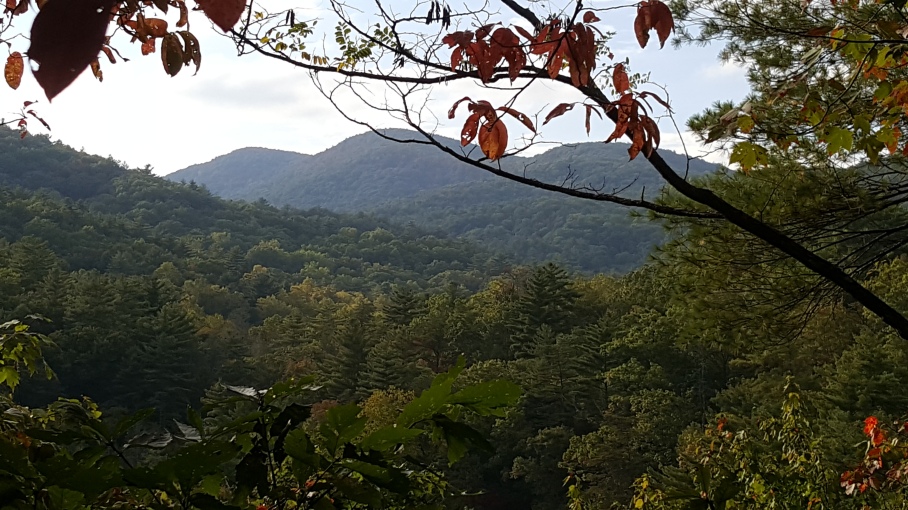



 Eventually, the trail leads to the end of Johnnie’s Creek as it (normally) flows into Little River. Unfortunately, the creek is dry when today. This is common for hikes in early autumn, but still kind of annoying. Black rocks jut from the ground where water would normally flow, obviously making it easy to traverse the creek bed. I can’t help but wonder what the rapids must look like when the creek is running.
Eventually, the trail leads to the end of Johnnie’s Creek as it (normally) flows into Little River. Unfortunately, the creek is dry when today. This is common for hikes in early autumn, but still kind of annoying. Black rocks jut from the ground where water would normally flow, obviously making it easy to traverse the creek bed. I can’t help but wonder what the rapids must look like when the creek is running.

